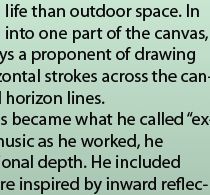| |
|
||||||||||||||
| |
 |
|
|
||||||||||||
| |
 |
|
 |
|
|
||||||||||
 |
 |
 |
|
||||||||||||
| |
|
|
|
||||||||||||
 |
|
|
|||||||||||||
 |
|
||||||||||||||
| Continued... |  |
|
|||||||||||||
 |
|
||||||||||||||
 |
|
||||||||||||||
 |
|
|
|||||||||||||
| |
|
|
|
||||||||||||
| |
|
||||||||||||||
| |
|
||||||||||||||
| |
|
|
|
|
|
|
|
|
|
|
|
|
|
|
|
|
He was consumed with pure abstraction and became one of the most
prominent colorists and abstract-expressionists of the time. His work
was receiving national acclaim. The Guggenheim Museum included his paintings
in its exhibition of “Younger American Painters” and he
received the Abraham Rosenberg Traveling Fellowship for the Advanced
Study of Art. |
Biography | Comparison | Links | Sausalito | Albuquerque | Urbana | Ocean Park